
Hermit crabs are anomuran decapod crustaceans of the superfamily Paguroidea that have adapted to occupy empty scavenged mollusc shells to protect their fragile exoskeletons. There are over 800 species of hermit crab, most of which possess an asymmetric abdomen concealed by a snug-fitting shell. Hermit crabs' soft (non-calcified) abdominal exoskeleton means they must occupy shelter produced by other organisms or risk being defenseless.

The halloween hermit crab, also known as the striped hermit crab or orange-legged hermit crab, is a brightly colored aquatic hermit crab of the family Diogenidae. Besides its ability to routinely clean algae in aquaria, the halloween hermit crab's festive striped coloration also appeals to enthusiasts; it is considered the most brightly colored hermit crab in normal aquarium use.

Coenobita cavipes is a species of land hermit crab native to the eastern parts of Africa, the Indonesia, Philippines, China, Japan, Malaysia, Taiwan, Polynesia, and Micronesia. While these hermit crabs are terrestrial, they prefer to reside near the shores for access of both water and land.

Paguristes cadenati, the red reef hermit crab or scarlet hermit crab, is a small species of hermit crab with a bright red body and yellow eyestalks that lives in the Caribbean Sea. The specific name honours the French ichthyologist Jean Cadenat (1908-1992), who collected the type specimen and sent it to the French carcinologist Jacques Forest, who described it as a new species.
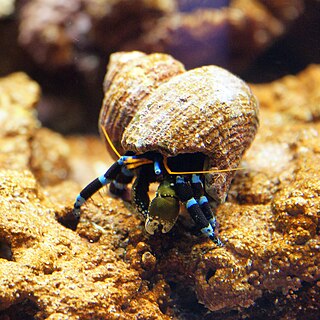
Calcinus elegans, also known as the blue line hermit crab, is a small, tropical hermit crab.
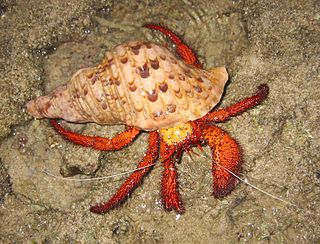
Dardanus megistos, the white-spotted hermit crab or spotted hermit crab, is a species of hermit crab belonging to the family Diogenidae.

Lybia tessellata is a species of small crab in the family Xanthidae. It is found in shallow parts of the tropical Indo-Pacific Ocean. They are found from the east coast of Africa in the Red Sea across Northern Japan and Northern and Eastern Hawaii. Like other members of the genus Lybia, it is commonly known as the pom-pom crab,cheerleader crab, or boxer crab because of its habit of carrying a sea anemone around in each of its claws, these resembling pom-poms or boxing gloves.

The thinstripe hermit crab, Clibanarius vittatus, is a species of hermit crab in the family Diogenidae. It is found in the Caribbean Sea, the Gulf of Mexico and the western Atlantic Ocean.
Calcinus verrillii, commonly known as Verrill's hermit crab, is a species of hermit crab in the genus Calcinus which is endemic to Bermuda. It was first described by the American zoologist Mary J. Rathbun and named in honour of the American zoologist Addison Emery Verrill, who spent much time with his students studying the geology and marine fauna of Bermuda.

Charybdis natator, the ridged swimming crab, wrinkled swimming crab or rock crab, is a widespread Indo-Pacific species of swimming crab from the genus Charybdis. It gets its name from the ridges on the dorsal surface of the carapace. It is a crab species which is of minor importance in fisheries.
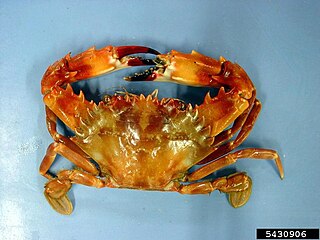
Charybdis hellerii, the Indo-Pacific swimming crab or spiny hands is a species of crab from the swimming crab family, the Portunidae. Its native range covers the Indian and Pacific Oceans but it has been introduced to the western Atlantic and has invaded the Mediterranean. It is a commercially exploited species in south-east Asia.

Calcinus morgani, commonly known as Morgan's hermit crab, is a species of hermit crab in the family Diogenidae found in the Indo-West Pacific region, the type locality being Indonesia.
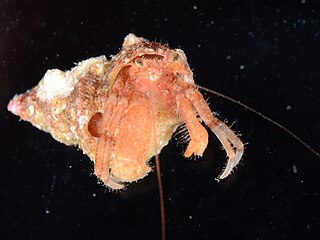
Pagurus dalli, commonly known as the whiteknee hermit or whiteknee hermit crab, is a species of hermit crab in the family Paguridae. It is found in the northeastern Pacific Ocean at depths down to about 276 m (900 ft). It usually lives in a mutualistic symbiosis with a sponge, or sometimes a hydroid.
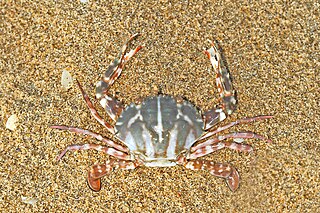
Charybdis feriata, the crucifix crab, is a species of swimming crab in the family Portunidae. It is found in the tropical and subtropical Indo-Pacific region.
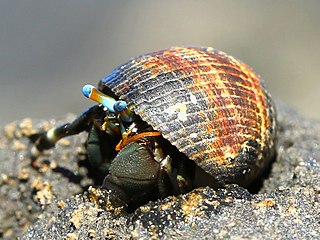
Calcinus seurati, commonly known as Seurat's hermit crab or whitebanded hermit, is a species of hermit crab in the family Diogenidae. It was first described by French carcinologist Jacques Forest in 1951. This species is found in rocky pools where they would be seen crawling out to the wet, algae-covered rocks. Calcinus seurati can be found in Indo-Pacific regions around the tropical area.

Philinopsis speciosa, the blue-lined philinopsis, is a species of sea slug, a shell-less opisthobranch gastropod mollusc in the family Aglajidae.
Calcinus argus, also known as the Argus hermit crab, is a species of hermit crabs in the family Diogenidae described by David Wooster in 1984. Originating from the Indo-West Pacific near Hawaii.
Calcinus guamensis is a species of hermit crab belonging to the Diogenidae family. First discovered by D.S. Wooster in 1982, this species primarily lives in the tropical waters of the Indo-Pacific region, including Guam and Hawaii. It is one of several species in the genus Calcinus, known for their uneven claws and reliance on gastropod shells for protection.

Calcinus laurentae is a species of left-handed hermit crab in the family Diogenidae. The common name for Calcinus laurentae is Laurent's Hermit Crab or Redleg calcinus. Calcinus laurentae are native to Hawaii and the Hawaiian word for hermit crab is unauna.
Calcinus revi, commonly known as the white hermit crab, is a species of hermit crabs in the family Diogenidae.
















